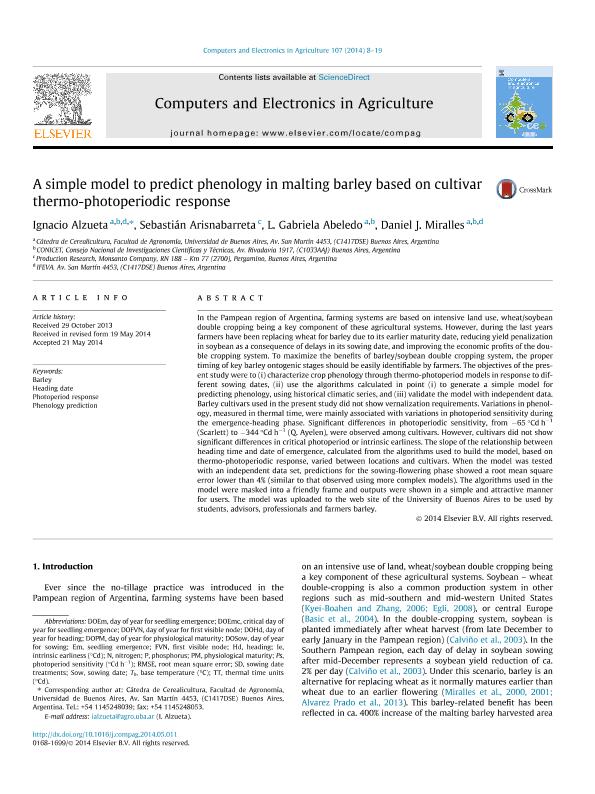Artículo
A simple model to predict phenology in malting barley based on cultivar thermo-photoperiodic response
Alzueta, Ignacio ; Arisnabarreta Dupuy, Sebastián; Abeledo, Leonor Gabriela
; Arisnabarreta Dupuy, Sebastián; Abeledo, Leonor Gabriela ; Miralles, Daniel Julio
; Miralles, Daniel Julio
 ; Arisnabarreta Dupuy, Sebastián; Abeledo, Leonor Gabriela
; Arisnabarreta Dupuy, Sebastián; Abeledo, Leonor Gabriela ; Miralles, Daniel Julio
; Miralles, Daniel Julio
Fecha de publicación:
07/2014
Editorial:
Elsevier
Revista:
Computers and Eletronics in Agriculture
ISSN:
0168-1699
Idioma:
Inglés
Tipo de recurso:
Artículo publicado
Clasificación temática:
Resumen
In the Pampean region of Argentina, farming systems are based on intensive land use, wheat/soybean double cropping being a key component of these agricultural systems. However, during the last years farmers have been replacing wheat for barley due to its earlier maturity date, reducing yield penalization in soybean as a consequence of delays in its sowing date, and improving the economic profits of the double cropping system. To maximize the benefits of barley/soybean double cropping system, the proper timing of key barley ontogenic stages should be easily identifiable by farmers. The objectives of the present study were to (i) characterize crop phenology through thermo-photoperiod models in response to different sowing dates, (ii) use the algorithms calculated in point (i) to generate a simple model for predicting phenology, using historical climatic series, and (iii) validate the model with independent data. Barley cultivars used in the present study did not show vernalization requirements. Variations in phenology, measured in thermal time, were mainly associated with variations in photoperiod sensitivity during the emergence-heading phase. Significant differences in photoperiodic sensitivity, from −65 °Cd h−1 (Scarlett) to −344 °Cd h−1 (Q. Ayelen), were observed among cultivars. However, cultivars did not show significant differences in critical photoperiod or intrinsic earliness. The slope of the relationship between heading time and date of emergence, calculated from the algorithms used to build the model, based on thermo-photoperiodic response, varied between locations and cultivars. When the model was tested with an independent data set, predictions for the sowing-flowering phase showed a root mean square error lower than 4% (similar to that observed using more complex models). The algorithms used in the model were masked into a friendly frame and outputs were shown in a simple and attractive manner for users. The model was uploaded to the web site of the University of Buenos Aires to be used by students, advisors, professionals and farmers barley.
Palabras clave:
Phenology
,
Barley
Archivos asociados
Licencia
Identificadores
Colecciones
Articulos(IFEVA)
Articulos de INST.D/INV.FISIOLOGICAS Y ECO.VINCULADAS A L/AGRIC
Articulos de INST.D/INV.FISIOLOGICAS Y ECO.VINCULADAS A L/AGRIC
Articulos(OCA PQUE. CENTENARIO)
Articulos de OFICINA DE COORDINACION ADMINISTRATIVA PQUE. CENTENARIO
Articulos de OFICINA DE COORDINACION ADMINISTRATIVA PQUE. CENTENARIO
Articulos(SEDE CENTRAL)
Articulos de SEDE CENTRAL
Articulos de SEDE CENTRAL
Citación
Alzueta, Ignacio; Arisnabarreta Dupuy, Sebastián; Abeledo, Leonor Gabriela; Miralles, Daniel Julio; A simple model to predict phenology in malting barley based on cultivar thermo-photoperiodic response; Elsevier; Computers and Eletronics in Agriculture; 107; 7-2014; 8-19
Compartir
Altmétricas



